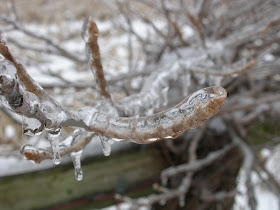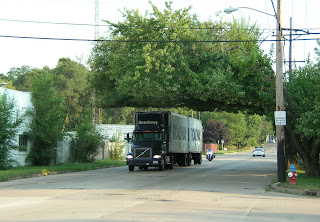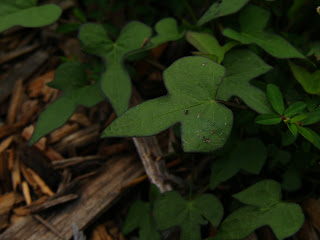Here are the quotes that Karen and I read to accompany the composite slide show.
Achillea millefolium (yarrow)
Sister Yarrow, Knight’s Milfoil,
grown near battlegrounds,
harvested by squires before sword-clang.
Soldier’s Woundwort
clotted blood through Britain,
staunched the flow on Russian steppes,
saved riders of the Golden Horde,
sanguinary poultice,
love charm, astringent tea.
-John Caddy,
http://www.morning-earth.org/Index.htmlAntennaria parlinii (Parlin’s pussytoes)
The flowers of late winter and early spring occupy places in our hearts well out of proportion to their size.
-Gertrude S. Wister
Aster ericoides (heath aster)
Chide me not, laborious band!
For the idle flowers I brought;
Every aster in my hand
Goes home loaded with a thought.
-
Ralph Waldo Emerson, The Apology
Aster lateriflorus (side-flowering aster)
The Autumn wood the aster knows,
The empty nest, the wind that grieves,
The sunlight breaking thro' the shade,
The squirrel chattering overhead,
The timid rabbits lighter tread
Among the rustling leaves.
-
Dora Read Goodale, Asters
Aster novae-angliae (New England aster)
The purple asters bloom in crowds
In every shady nook,
And ladies’ eardrops deck the banks
Of many a babbling brook.
-Elaine Goodale, Autumn
Aster shortii (Short’s aster)
The aster greets us as we pass
With her faint smile.
-
Mrs. Sarah Helen Power Whitman, A Day of the Indian Summer
Aster umbellatus (flat-top aster)
One dark and stormy night in 1994 I was awakened from a deep sleep by a loud thump. Creeping carefully down the stairs, I discovered to my astonishment that a large bouquet of Aster on the dining table had disappeared! In its place was a cornucopia of composites, including Symphyotrichum, Ionactis, Eurybia, Sericocarpus, Doellingeria, Ampelaster, and Oclemena! Once again, a plant taxonomist had struck in dark of night, taken a simple two-syllable genus with the same English common name, and replaced it with a handful of four- and five-syllable Latin tongue-twisters. Whatever can we do about such things?
-Alan Weakly, The Curious Case of the Disappearing Asters
Cacalia plantaginea (prairie Indian plantain)
For myself I hold no preferences among flowers, so long as they are wild, free, spontaneous. Bricks to all greenhouses! Black thumb and cutworm to the potted plant!
-Edward Abbey
Carduus nutans (musk thistle)
When on the breath of Autumn's breeze,
From pastures day and brown,
Goes floating, like an idle thought,
The fair, white thistle-down;
O, then what joy to walk at will,
Upon the golden harvest-hill!
-
Mary Howitt, Corn-Fields
Centaurea maculosa (spotted knapweed)
What is a weed? I have heard it said that there are sixty definitions. For me, a weed is a plant out of place.
-Donald Culross Peattie
Chrysanthemum leucanthemum (ox-eye daisy)
All summer she scattered the daisy leaves;
They only mocked her as they fell.
She said: "The daisy but deceives;
'He loves me not,' 'he loves me will,'
One story no two daisies tell."
Ah foolish heart, which waits and grieves
Under the daisy's mocking spell.
-
Helen Hunt Jackson (Helen Hunt), The Sign of the Daisy
Cichorium intybus (chicory)
It has made its way, on wind,
far into the city, and it nods there,
on streetcorners, in what July wind
its slips garner. Since childhood
I have loved it, it is so violet-blue,
its root, its marrow, so interred,
prepared to suffer, impossible to move.
Weed, wildflower, grown waist-high
where it is no one’s responsibility
to mow, its blue-white
center frankly open
as an eye, it flaunts
its tender, living lingerie,
the purple hairs of its interior.
Women are weeds and weeds are women,
I once heard a woman say.
Bloom where you are planted, said my mother.
-Catherine Rankovic, Blue Chicory
Coreopsis lanceolata (sand coreopsis)
The mockingbird says, Hallelujah, coreopsis, I make the day bright, I wake the night-booming jasmine.
-Barbara Hamby, from Thus Spake the Mockingbird
Coreopsis tripteris (tall coreopsis)
With zealous step he climbs the upland lawn,
And bows in homage to the rising dawn;
Imbibes with eagle eye the golden ray,
And watches, as it moves, the orb of day.
-
Erasmus Darwin, Loves of the Plants
Echinacea pallida (purple coneflower)
Flowers construct the most charming geometries: circles like the sun,
ovals, cones, curlicues and a variety of triangular eccentricities, which
when viewed with the eye of a magnifying glass seem a Lilliputian
frieze of psychedelic silhouettes.
- Duane Michals, The Vanishing Act
Erigeron philadelphicus (marsh fleabane)
There is a flower, a little flower
With silver crest and golden eye,
That welcomes every changing hour,
And weathers every sky.
-
James Montgomery, A Field Flower
Eupatorium maculatum (spotted Joe Pye weed)
The joe-pye weeds will stand as sentinels
Their lavender riches offered to the sky.
The prairie grasses, gardens of the desert,
Will move in a rhythm to match our own.
-Kathy Stevenson, from Prairie Reverie
Helenium autumnale (sneezeweed)
Radiant color
In amber fields of plenty
Celebrate summer
-Karla Dorman, Sunflower Fields
Helianthus divaricatus (woodland sunflower)
Light-enchanted sunflower, thou
Who gazest ever true and tender
On the sun's revolving splendour.
-
Pedro Calderon de la Barca, Magico Prodigioso (sc. 3), (Shelley's translation)
Helianthus giganteus (tall sunflower)
And the yellow sunflower by the brook, in autumn beauty stood.
-
William Cullen BryantHelianthus occidentalis (western sunflower)
You're expected to see
only the top, where sky
scrambles bloom, and not
the spindly leg, hairy, fending off
tall, green darkness beneath.
Like every flower, she has a little
theory, and what she thinks
is up. I imagine the long
climb out of the dark
beyond morning glories, day lilies, four o'clocks
up there to the dream she keeps
lifting, where it's noon all day.
-Frank Steele, Sunflower
Heliopsis helianthoides (false sunflower)
The Sunflow'r, thinking 'twas for him foul shame
To nap by daylight, strove t' excuse the blame;
It was not sleep that made him nod, he said,
But too great weight and largeness of his head.
-
Abraham Cowley, Of Plants
Krigia biflora (false dandelion)
Little girls, and boys come out to play
Bring your dandelions to blow away
Dandelion don't tell no lies
Dandelion will make you wise
Tell me if she laughs or cries
Blow away dandelion, blow away dandelion
-The Rolling Stones, Dandelion
Liatris spicata (marsh blazing star),
Liatris aspera (rough blazing star)
One by one the prairie species come,
Fill every niche of time and light.
Their names spill into poems on the tongue,
Liatris, aster, needlegrass. We watch
The wash of Renoir's colors through
The bluestem grass, the herons sweeping
Home. In evening light the junipers
Could almost be bison, gently grazing.
-Robin Chapman, Prairie Restoration
Parthenium integrifolium (wild quinine)
To see a World in a Grain of Sand
And a Heaven in a Wild Flower,
Hold Infinity in the palm of your hand
And Eternity in an hour.
-William Blake, Auguries of Innocence (excerpt)
Prenanthes racemosa (glaucous white lettuce)
'Tis my faith that every flower
Enjoys the air it breathes!
- William Wordsworth, "Lines Written in Early Spring," Lyrical Ballads, 1798
Ratibida pinnata (yellow coneflower)
Eagle of flowers! I see thee stand,
And on the sun's noon-glory gaze;
With eye like his, thy lids expand,
And fringe their disk with golden rays:
Though fix'd on earth, in darkness rooted there,
Light is thy element, thy dwelling air,
Thy prospect heaven.-
James Montgomery, The Sunflower
Rudbeckia hirta (black-eyed Susan)
All in the Downs the fleet was moor’d,
The streamers waving in the wind,
When black-eyed Susan came aboard;
‘O! where shall I my true-love find?
Tell me, ye jovial sailors, tell me true
If my sweet William sails among the crew.’
-John Gay, Black-eyed Susan (excerpt)
Rudbeckia laciniata (wild golden glow)
O Susan, Susan, lovely dear,
My vows shall ever true remain;
Let me kiss off that falling tear,
We only part to meet again.
Change, as ye list, ye winds; my heart shall be
The faithful compass that still points to thee.
-John Gay, Sweet William’s Farewell to Black-eyed Susan (excerpt)
Senecio obovatus (round-leaved ragwort)
Ragwort thou humble flower with tattered leaves
I love to see thee come and litter gold
- John Clare c.1835, The Ragwort
Silphium integrifolium (rosin weed),
Silphium laciniatum (compass plant)
Look at this vigorous plant that lifts its head from the meadow,
See how its leaves are turned to the north, as true as the magnet;
This is the compass-flower, that the finger of God has planted
Here in the houseless wild, to direct the traveller's journey.
Over the sea-like, pathless, limitless waste of the desert,
Such in the soul of man is faith.
-
Henry Wadsworth Longfellow, Evangeline
Silphium terebinthinaceum (prairie dock)
I see you there in glory shining bright,
Following the sun and its path of light.
Standing tall above all others in the field,
You grow, conquer, and do not yield.
- Katherine R. Lane, Poem to a Sunflower (excerpt)
Solidago juncea (early goldenrod)
Welcome, dear Goldenrod, once more,
Thou mimic, flowering elm!
I always think that Summer's store
Hangs from thy laden stem.
-
Horace Elisha Scudder, To the Goldenrod at Midsummer
Solidago ptarmicoides (stiff aster)
I am half dead with Aster. I got on very fairly until I got to the thick of the genus, around what I call the Dumosi and Salicifolia. Here I work and work, but make no headway at all. I can't tell what are species and how to define any of them ..... I was never so boggled ..... If you hear of my breaking down utterly, and being sent to an asylum, you may lay it to Aster, which is a slow and fatal poison."
- Asa Gray, late in his life
Solidago rigida (stiff goldenrod)
And in the evening, everywhere
Along the roadside, up and down,
I see the golden torches flare
Like lighted street-lamps in the town.
-
Frank Dempster Sherman, Golden-Rod
Solidago uliginosa (bog goldenrod)
Nature lies disheveled, pale,
With her feverish lips apart,--
Day by day the pulses fail,
Nearer to her bounding heart;
Yet that slackened grasp doth hold
Store of pure and genuine gold;
Quick thou comest, strong and free,
Type of all the wealth to be,--
Goldenrod!
-
Elaine Goodale (Mrs. Charles A. Eastman), Goldenrod
Taraxacum officinale (common dandelion)
Upon a showery night and still,
Without a sound of warning,
A trooper band surprised the hill,
And held it in the morning.
We were not waked by bugle notes,
No cheer our dreams invaded,
And yet at dawn, their yellow coats
On the green slopes paraded.
-
Helen Gray Cone, The Dandelions
Tragopogon dubius (sand goat’s beard)
Then did we question of the down-balls, blowing
To know if some slight wish would come to pass
-Quoted by Ann Pratt, Wild Flowers (1857)
+2_6-19-2008_Shaw+Park+Botanical+Gardens,+Jamaica.JPG)
+3_6-19-2008_Shaw+Park+Botanical+Gardens,+Jamaica.JPG)








 Admittedly, I have mostly ignored Gaura biennis over the years; finding it gangly and somewhat weedy. But it really out-did itself this year and I took notice. Camera in hand, tripod in tow, I headed down my gravel driveway to a nice specimen for a quick photo. Knowing them to be nocturnal bloomers and having noticed that the flowers were at their peak in the morning when I left the house and mostly shriveled by my evening return, I got to them just after sunrise.
Admittedly, I have mostly ignored Gaura biennis over the years; finding it gangly and somewhat weedy. But it really out-did itself this year and I took notice. Camera in hand, tripod in tow, I headed down my gravel driveway to a nice specimen for a quick photo. Knowing them to be nocturnal bloomers and having noticed that the flowers were at their peak in the morning when I left the house and mostly shriveled by my evening return, I got to them just after sunrise.  Returning to the house, I grabbed my copy of "Butterflies and Moths of Missouri" and looked for moths that feed on Gaura that might fit what has to be an interesting pollination syndrome. I found that Schinia gaurae (the Clouded Crimson)(picture below from pbase.com) feeds, nectars, rests and lays eggs on species of Gaura and primarily on Gaura biennis. Still curious, I googled for images of this fun little moth. Several of the images demonstrated that the moth is almost the identical size and shape of the stamen arrangement on the Gaura biennis flowers. I also noticed that the back end of its wings are somewhat fluffy, not unlike miniature feather dusters. To cap it off, the adult moth's peak emergence is well in line with the bloom dates of G. biennis.
Returning to the house, I grabbed my copy of "Butterflies and Moths of Missouri" and looked for moths that feed on Gaura that might fit what has to be an interesting pollination syndrome. I found that Schinia gaurae (the Clouded Crimson)(picture below from pbase.com) feeds, nectars, rests and lays eggs on species of Gaura and primarily on Gaura biennis. Still curious, I googled for images of this fun little moth. Several of the images demonstrated that the moth is almost the identical size and shape of the stamen arrangement on the Gaura biennis flowers. I also noticed that the back end of its wings are somewhat fluffy, not unlike miniature feather dusters. To cap it off, the adult moth's peak emergence is well in line with the bloom dates of G. biennis. So at this point I am thinking that Schinia gaurae obviously visits the flowers to get a little nectar and as it aligns itself to drink, the fluffy wing bases get dusted with pollen. It just makes too much sense. Unfortunately, the only references I can find says that G. biennis is pollinated by long-tongued bees. My dream of a "form meets function" world instantly goes up in a cloud of disappointment. After all, what do these Gene Simmons bees have to do with my elaborate Gaura stamens? Are there really nocturnal bees? I needed more info.
So at this point I am thinking that Schinia gaurae obviously visits the flowers to get a little nectar and as it aligns itself to drink, the fluffy wing bases get dusted with pollen. It just makes too much sense. Unfortunately, the only references I can find says that G. biennis is pollinated by long-tongued bees. My dream of a "form meets function" world instantly goes up in a cloud of disappointment. After all, what do these Gene Simmons bees have to do with my elaborate Gaura stamens? Are there really nocturnal bees? I needed more info.



































